Pokedex Java Project: Arrays and Objects
VerifiedAdded on 2019/09/16
|9
|2673
|629
Project
AI Summary
This project involves creating a text-based Pokedex program in Java using arrays and objects. The program allows users to add new Pokemon species, list all stored Pokemon, check individual Pokemon statistics, and sort the Pokedex alphabetically. The project requires the creation of three Java files: Pokemon.java, Pokedex.java, and Project4.java. The Pokemon class defines Pokemon attributes and methods, while the Pokedex class manages an array of Pokemon objects and provides functionalities like adding, listing, checking stats, and sorting. The Project4 class contains the main method and handles user input. The program should mimic the output of the provided sample runs, and the code should be well-commented.
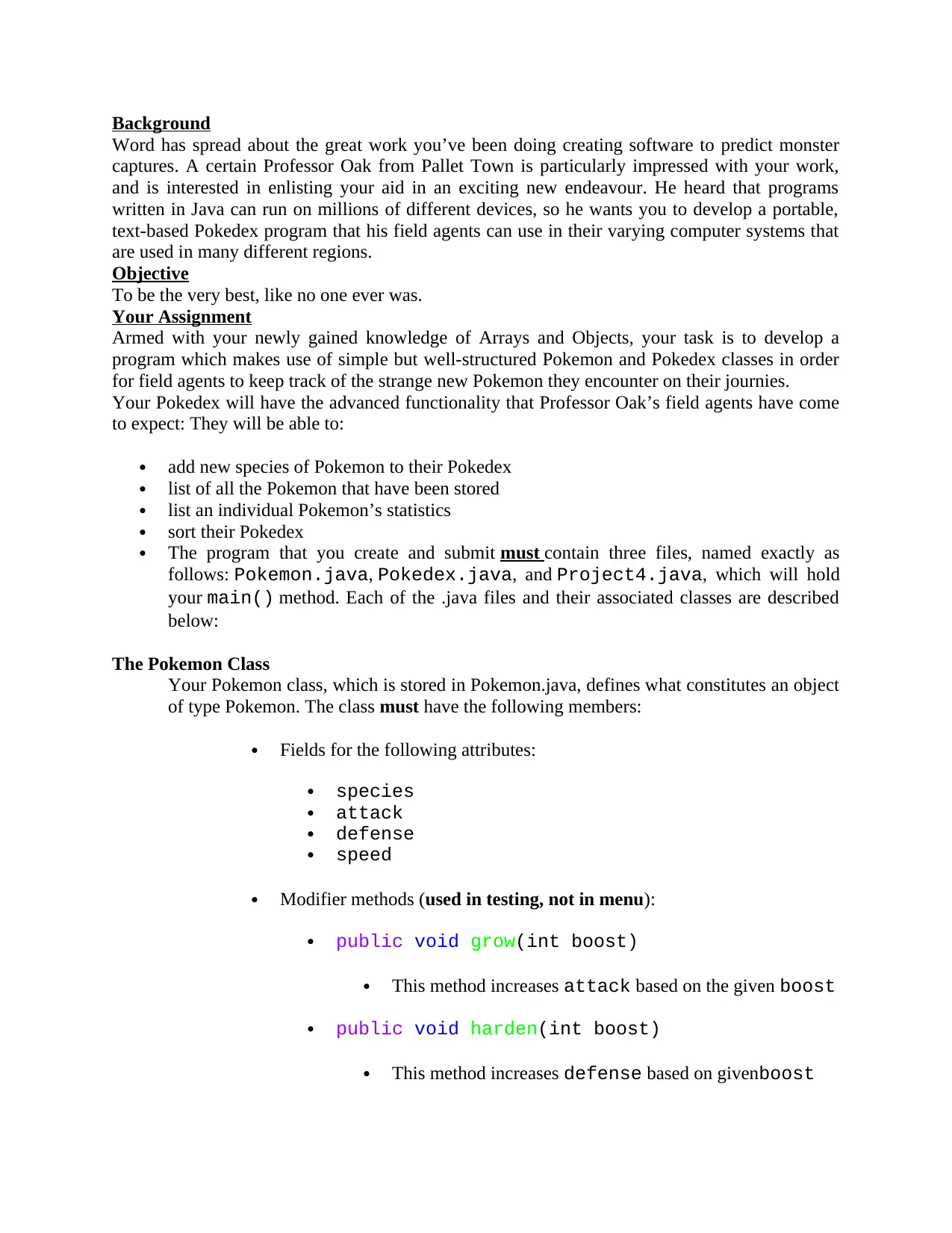
Background
Word has spread about the great work you’ve been doing creating software to predict monster
captures. A certain Professor Oak from Pallet Town is particularly impressed with your work,
and is interested in enlisting your aid in an exciting new endeavour. He heard that programs
written in Java can run on millions of different devices, so he wants you to develop a portable,
text-based Pokedex program that his field agents can use in their varying computer systems that
are used in many different regions.
Objective
To be the very best, like no one ever was.
Your Assignment
Armed with your newly gained knowledge of Arrays and Objects, your task is to develop a
program which makes use of simple but well-structured Pokemon and Pokedex classes in order
for field agents to keep track of the strange new Pokemon they encounter on their journies.
Your Pokedex will have the advanced functionality that Professor Oak’s field agents have come
to expect: They will be able to:
add new species of Pokemon to their Pokedex
list of all the Pokemon that have been stored
list an individual Pokemon’s statistics
sort their Pokedex
The program that you create and submit must contain three files, named exactly as
follows: Pokemon.java, Pokedex.java, and Project4.java, which will hold
your main() method. Each of the .java files and their associated classes are described
below:
The Pokemon Class
Your Pokemon class, which is stored in Pokemon.java, defines what constitutes an object
of type Pokemon. The class must have the following members:
Fields for the following attributes:
species
attack
defense
speed
Modifier methods (used in testing, not in menu):
public void grow(int boost)
This method increases attack based on the given boost
public void harden(int boost)
This method increases defense based on givenboost
Word has spread about the great work you’ve been doing creating software to predict monster
captures. A certain Professor Oak from Pallet Town is particularly impressed with your work,
and is interested in enlisting your aid in an exciting new endeavour. He heard that programs
written in Java can run on millions of different devices, so he wants you to develop a portable,
text-based Pokedex program that his field agents can use in their varying computer systems that
are used in many different regions.
Objective
To be the very best, like no one ever was.
Your Assignment
Armed with your newly gained knowledge of Arrays and Objects, your task is to develop a
program which makes use of simple but well-structured Pokemon and Pokedex classes in order
for field agents to keep track of the strange new Pokemon they encounter on their journies.
Your Pokedex will have the advanced functionality that Professor Oak’s field agents have come
to expect: They will be able to:
add new species of Pokemon to their Pokedex
list of all the Pokemon that have been stored
list an individual Pokemon’s statistics
sort their Pokedex
The program that you create and submit must contain three files, named exactly as
follows: Pokemon.java, Pokedex.java, and Project4.java, which will hold
your main() method. Each of the .java files and their associated classes are described
below:
The Pokemon Class
Your Pokemon class, which is stored in Pokemon.java, defines what constitutes an object
of type Pokemon. The class must have the following members:
Fields for the following attributes:
species
attack
defense
speed
Modifier methods (used in testing, not in menu):
public void grow(int boost)
This method increases attack based on the given boost
public void harden(int boost)
This method increases defense based on givenboost
Paraphrase This Document
Need a fresh take? Get an instant paraphrase of this document with our AI Paraphraser
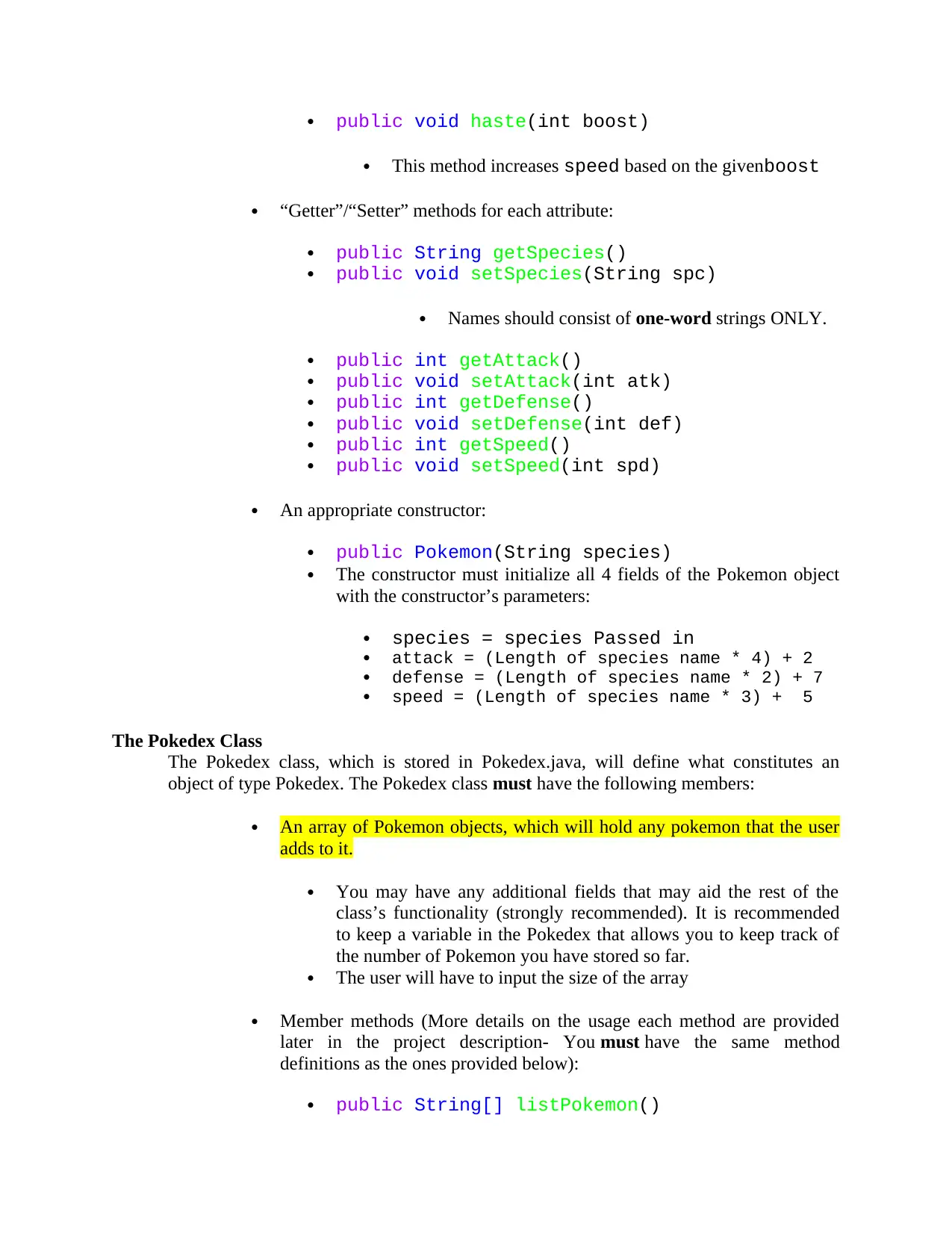
public void haste(int boost)
This method increases speed based on the givenboost
“Getter”/“Setter” methods for each attribute:
public String getSpecies()
public void setSpecies(String spc)
Names should consist of one-word strings ONLY.
public int getAttack()
public void setAttack(int atk)
public int getDefense()
public void setDefense(int def)
public int getSpeed()
public void setSpeed(int spd)
An appropriate constructor:
public Pokemon(String species)
The constructor must initialize all 4 fields of the Pokemon object
with the constructor’s parameters:
species = species Passed in
attack = (Length of species name * 4) + 2
defense = (Length of species name * 2) + 7
speed = (Length of species name * 3) + 5
The Pokedex Class
The Pokedex class, which is stored in Pokedex.java, will define what constitutes an
object of type Pokedex. The Pokedex class must have the following members:
An array of Pokemon objects, which will hold any pokemon that the user
adds to it.
You may have any additional fields that may aid the rest of the
class’s functionality (strongly recommended). It is recommended
to keep a variable in the Pokedex that allows you to keep track of
the number of Pokemon you have stored so far.
The user will have to input the size of the array
Member methods (More details on the usage each method are provided
later in the project description- You must have the same method
definitions as the ones provided below):
public String[] listPokemon()
This method increases speed based on the givenboost
“Getter”/“Setter” methods for each attribute:
public String getSpecies()
public void setSpecies(String spc)
Names should consist of one-word strings ONLY.
public int getAttack()
public void setAttack(int atk)
public int getDefense()
public void setDefense(int def)
public int getSpeed()
public void setSpeed(int spd)
An appropriate constructor:
public Pokemon(String species)
The constructor must initialize all 4 fields of the Pokemon object
with the constructor’s parameters:
species = species Passed in
attack = (Length of species name * 4) + 2
defense = (Length of species name * 2) + 7
speed = (Length of species name * 3) + 5
The Pokedex Class
The Pokedex class, which is stored in Pokedex.java, will define what constitutes an
object of type Pokedex. The Pokedex class must have the following members:
An array of Pokemon objects, which will hold any pokemon that the user
adds to it.
You may have any additional fields that may aid the rest of the
class’s functionality (strongly recommended). It is recommended
to keep a variable in the Pokedex that allows you to keep track of
the number of Pokemon you have stored so far.
The user will have to input the size of the array
Member methods (More details on the usage each method are provided
later in the project description- You must have the same method
definitions as the ones provided below):
public String[] listPokemon()
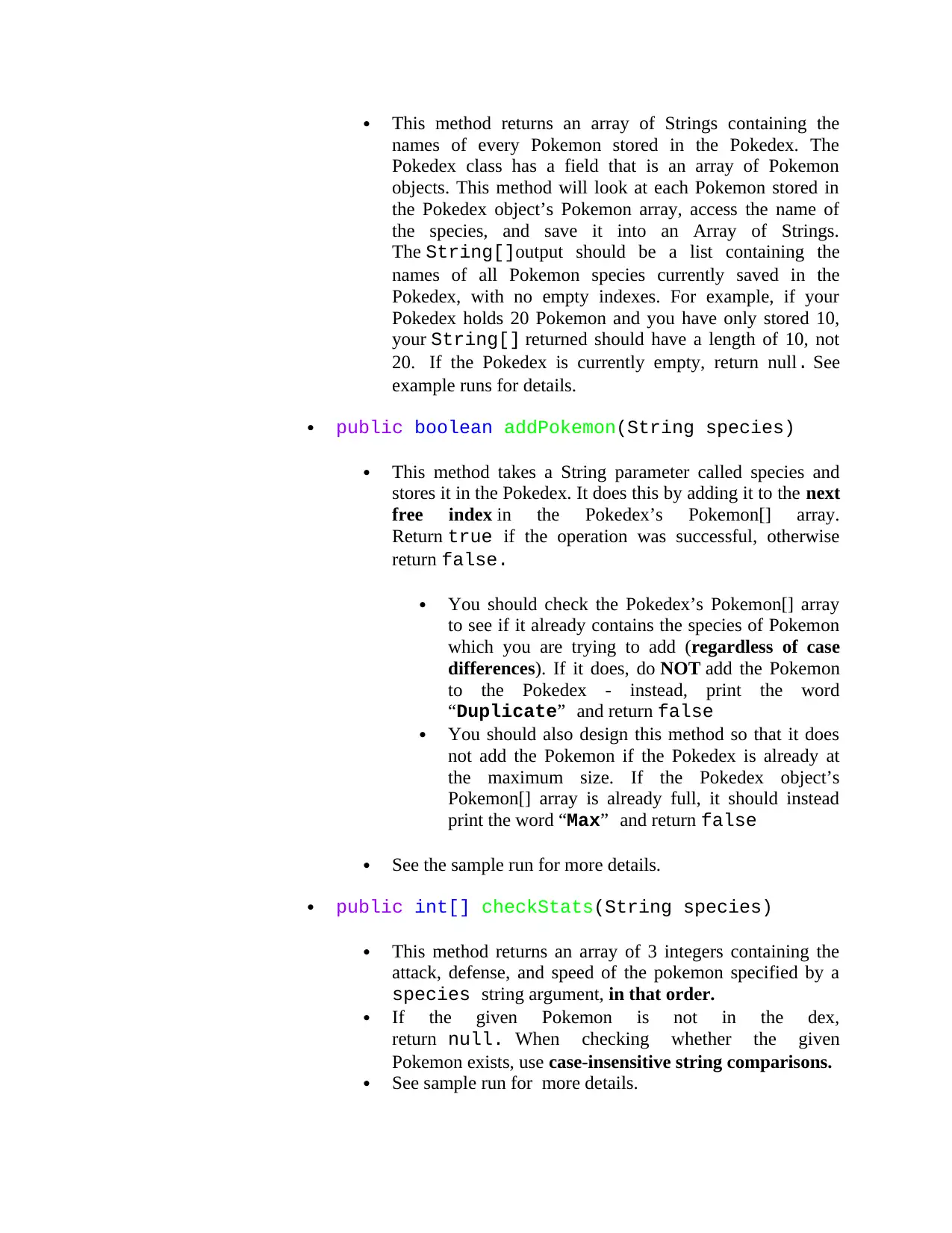
This method returns an array of Strings containing the
names of every Pokemon stored in the Pokedex. The
Pokedex class has a field that is an array of Pokemon
objects. This method will look at each Pokemon stored in
the Pokedex object’s Pokemon array, access the name of
the species, and save it into an Array of Strings.
The String[]output should be a list containing the
names of all Pokemon species currently saved in the
Pokedex, with no empty indexes. For example, if your
Pokedex holds 20 Pokemon and you have only stored 10,
your String[] returned should have a length of 10, not
20. If the Pokedex is currently empty, return null. See
example runs for details.
public boolean addPokemon(String species)
This method takes a String parameter called species and
stores it in the Pokedex. It does this by adding it to the next
free index in the Pokedex’s Pokemon[] array.
Return true if the operation was successful, otherwise
return false.
You should check the Pokedex’s Pokemon[] array
to see if it already contains the species of Pokemon
which you are trying to add (regardless of case
differences). If it does, do NOT add the Pokemon
to the Pokedex - instead, print the word
“Duplicate” and return false
You should also design this method so that it does
not add the Pokemon if the Pokedex is already at
the maximum size. If the Pokedex object’s
Pokemon[] array is already full, it should instead
print the word “Max” and return false
See the sample run for more details.
public int[] checkStats(String species)
This method returns an array of 3 integers containing the
attack, defense, and speed of the pokemon specified by a
species string argument, in that order.
If the given Pokemon is not in the dex,
return null. When checking whether the given
Pokemon exists, use case-insensitive string comparisons.
See sample run for more details.
names of every Pokemon stored in the Pokedex. The
Pokedex class has a field that is an array of Pokemon
objects. This method will look at each Pokemon stored in
the Pokedex object’s Pokemon array, access the name of
the species, and save it into an Array of Strings.
The String[]output should be a list containing the
names of all Pokemon species currently saved in the
Pokedex, with no empty indexes. For example, if your
Pokedex holds 20 Pokemon and you have only stored 10,
your String[] returned should have a length of 10, not
20. If the Pokedex is currently empty, return null. See
example runs for details.
public boolean addPokemon(String species)
This method takes a String parameter called species and
stores it in the Pokedex. It does this by adding it to the next
free index in the Pokedex’s Pokemon[] array.
Return true if the operation was successful, otherwise
return false.
You should check the Pokedex’s Pokemon[] array
to see if it already contains the species of Pokemon
which you are trying to add (regardless of case
differences). If it does, do NOT add the Pokemon
to the Pokedex - instead, print the word
“Duplicate” and return false
You should also design this method so that it does
not add the Pokemon if the Pokedex is already at
the maximum size. If the Pokedex object’s
Pokemon[] array is already full, it should instead
print the word “Max” and return false
See the sample run for more details.
public int[] checkStats(String species)
This method returns an array of 3 integers containing the
attack, defense, and speed of the pokemon specified by a
species string argument, in that order.
If the given Pokemon is not in the dex,
return null. When checking whether the given
Pokemon exists, use case-insensitive string comparisons.
See sample run for more details.
⊘ This is a preview!⊘
Do you want full access?
Subscribe today to unlock all pages.

Trusted by 1+ million students worldwide
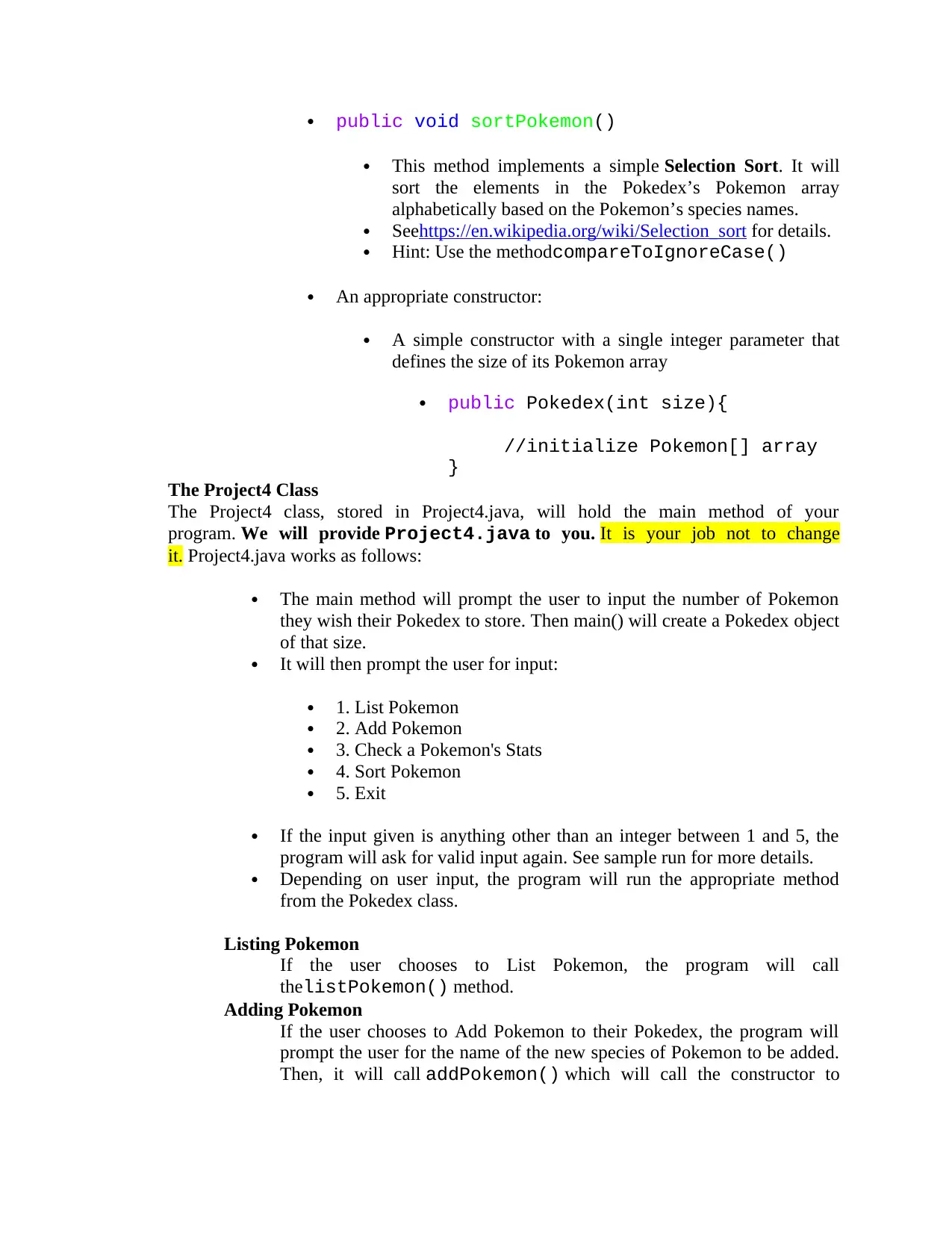
public void sortPokemon()
This method implements a simple Selection Sort. It will
sort the elements in the Pokedex’s Pokemon array
alphabetically based on the Pokemon’s species names.
Seehttps://en.wikipedia.org/wiki/Selection_sort for details.
Hint: Use the methodcompareToIgnoreCase()
An appropriate constructor:
A simple constructor with a single integer parameter that
defines the size of its Pokemon array
public Pokedex(int size){
//initialize Pokemon[] array
}
The Project4 Class
The Project4 class, stored in Project4.java, will hold the main method of your
program. We will provide Project4.java to you. It is your job not to change
it. Project4.java works as follows:
The main method will prompt the user to input the number of Pokemon
they wish their Pokedex to store. Then main() will create a Pokedex object
of that size.
It will then prompt the user for input:
1. List Pokemon
2. Add Pokemon
3. Check a Pokemon's Stats
4. Sort Pokemon
5. Exit
If the input given is anything other than an integer between 1 and 5, the
program will ask for valid input again. See sample run for more details.
Depending on user input, the program will run the appropriate method
from the Pokedex class.
Listing Pokemon
If the user chooses to List Pokemon, the program will call
thelistPokemon() method.
Adding Pokemon
If the user chooses to Add Pokemon to their Pokedex, the program will
prompt the user for the name of the new species of Pokemon to be added.
Then, it will call addPokemon() which will call the constructor to
This method implements a simple Selection Sort. It will
sort the elements in the Pokedex’s Pokemon array
alphabetically based on the Pokemon’s species names.
Seehttps://en.wikipedia.org/wiki/Selection_sort for details.
Hint: Use the methodcompareToIgnoreCase()
An appropriate constructor:
A simple constructor with a single integer parameter that
defines the size of its Pokemon array
public Pokedex(int size){
//initialize Pokemon[] array
}
The Project4 Class
The Project4 class, stored in Project4.java, will hold the main method of your
program. We will provide Project4.java to you. It is your job not to change
it. Project4.java works as follows:
The main method will prompt the user to input the number of Pokemon
they wish their Pokedex to store. Then main() will create a Pokedex object
of that size.
It will then prompt the user for input:
1. List Pokemon
2. Add Pokemon
3. Check a Pokemon's Stats
4. Sort Pokemon
5. Exit
If the input given is anything other than an integer between 1 and 5, the
program will ask for valid input again. See sample run for more details.
Depending on user input, the program will run the appropriate method
from the Pokedex class.
Listing Pokemon
If the user chooses to List Pokemon, the program will call
thelistPokemon() method.
Adding Pokemon
If the user chooses to Add Pokemon to their Pokedex, the program will
prompt the user for the name of the new species of Pokemon to be added.
Then, it will call addPokemon() which will call the constructor to
Paraphrase This Document
Need a fresh take? Get an instant paraphrase of this document with our AI Paraphraser
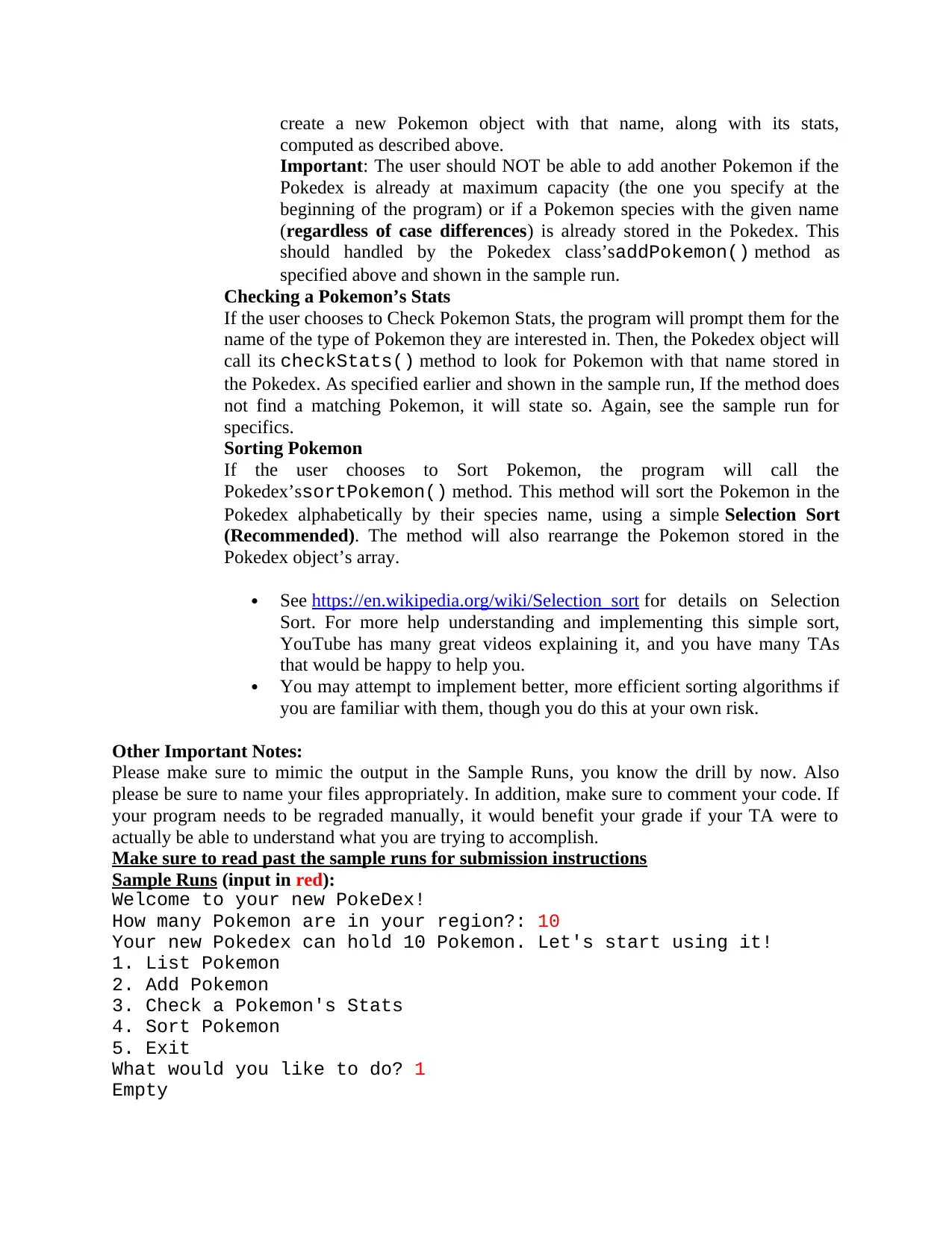
create a new Pokemon object with that name, along with its stats,
computed as described above.
Important: The user should NOT be able to add another Pokemon if the
Pokedex is already at maximum capacity (the one you specify at the
beginning of the program) or if a Pokemon species with the given name
(regardless of case differences) is already stored in the Pokedex. This
should handled by the Pokedex class’saddPokemon() method as
specified above and shown in the sample run.
Checking a Pokemon’s Stats
If the user chooses to Check Pokemon Stats, the program will prompt them for the
name of the type of Pokemon they are interested in. Then, the Pokedex object will
call its checkStats() method to look for Pokemon with that name stored in
the Pokedex. As specified earlier and shown in the sample run, If the method does
not find a matching Pokemon, it will state so. Again, see the sample run for
specifics.
Sorting Pokemon
If the user chooses to Sort Pokemon, the program will call the
Pokedex’ssortPokemon() method. This method will sort the Pokemon in the
Pokedex alphabetically by their species name, using a simple Selection Sort
(Recommended). The method will also rearrange the Pokemon stored in the
Pokedex object’s array.
See https://en.wikipedia.org/wiki/Selection_sort for details on Selection
Sort. For more help understanding and implementing this simple sort,
YouTube has many great videos explaining it, and you have many TAs
that would be happy to help you.
You may attempt to implement better, more efficient sorting algorithms if
you are familiar with them, though you do this at your own risk.
Other Important Notes:
Please make sure to mimic the output in the Sample Runs, you know the drill by now. Also
please be sure to name your files appropriately. In addition, make sure to comment your code. If
your program needs to be regraded manually, it would benefit your grade if your TA were to
actually be able to understand what you are trying to accomplish.
Make sure to read past the sample runs for submission instructions
Sample Runs (input in red):
Welcome to your new PokeDex!
How many Pokemon are in your region?: 10
Your new Pokedex can hold 10 Pokemon. Let's start using it!
1. List Pokemon
2. Add Pokemon
3. Check a Pokemon's Stats
4. Sort Pokemon
5. Exit
What would you like to do? 1
Empty
computed as described above.
Important: The user should NOT be able to add another Pokemon if the
Pokedex is already at maximum capacity (the one you specify at the
beginning of the program) or if a Pokemon species with the given name
(regardless of case differences) is already stored in the Pokedex. This
should handled by the Pokedex class’saddPokemon() method as
specified above and shown in the sample run.
Checking a Pokemon’s Stats
If the user chooses to Check Pokemon Stats, the program will prompt them for the
name of the type of Pokemon they are interested in. Then, the Pokedex object will
call its checkStats() method to look for Pokemon with that name stored in
the Pokedex. As specified earlier and shown in the sample run, If the method does
not find a matching Pokemon, it will state so. Again, see the sample run for
specifics.
Sorting Pokemon
If the user chooses to Sort Pokemon, the program will call the
Pokedex’ssortPokemon() method. This method will sort the Pokemon in the
Pokedex alphabetically by their species name, using a simple Selection Sort
(Recommended). The method will also rearrange the Pokemon stored in the
Pokedex object’s array.
See https://en.wikipedia.org/wiki/Selection_sort for details on Selection
Sort. For more help understanding and implementing this simple sort,
YouTube has many great videos explaining it, and you have many TAs
that would be happy to help you.
You may attempt to implement better, more efficient sorting algorithms if
you are familiar with them, though you do this at your own risk.
Other Important Notes:
Please make sure to mimic the output in the Sample Runs, you know the drill by now. Also
please be sure to name your files appropriately. In addition, make sure to comment your code. If
your program needs to be regraded manually, it would benefit your grade if your TA were to
actually be able to understand what you are trying to accomplish.
Make sure to read past the sample runs for submission instructions
Sample Runs (input in red):
Welcome to your new PokeDex!
How many Pokemon are in your region?: 10
Your new Pokedex can hold 10 Pokemon. Let's start using it!
1. List Pokemon
2. Add Pokemon
3. Check a Pokemon's Stats
4. Sort Pokemon
5. Exit
What would you like to do? 1
Empty
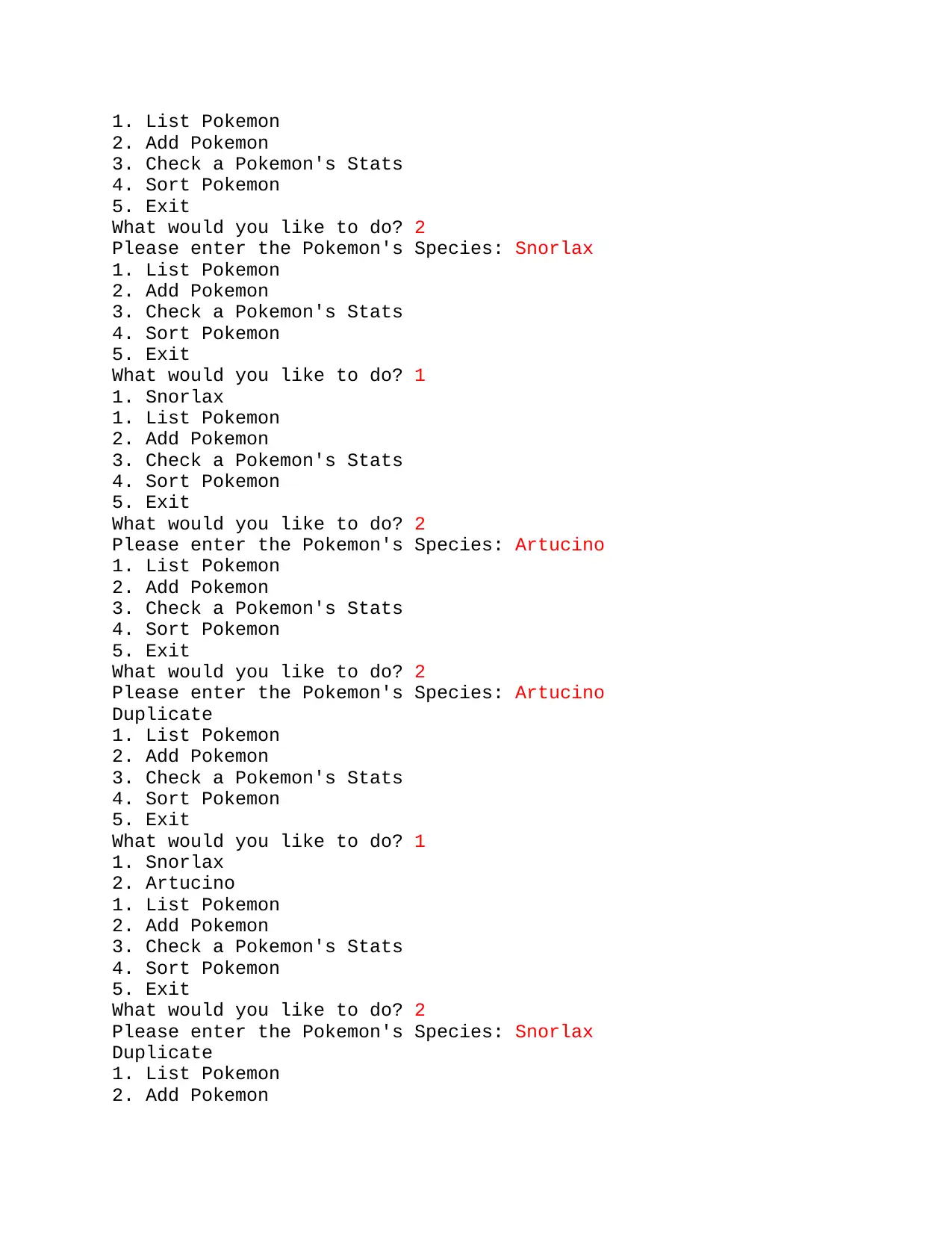
1. List Pokemon
2. Add Pokemon
3. Check a Pokemon's Stats
4. Sort Pokemon
5. Exit
What would you like to do? 2
Please enter the Pokemon's Species: Snorlax
1. List Pokemon
2. Add Pokemon
3. Check a Pokemon's Stats
4. Sort Pokemon
5. Exit
What would you like to do? 1
1. Snorlax
1. List Pokemon
2. Add Pokemon
3. Check a Pokemon's Stats
4. Sort Pokemon
5. Exit
What would you like to do? 2
Please enter the Pokemon's Species: Artucino
1. List Pokemon
2. Add Pokemon
3. Check a Pokemon's Stats
4. Sort Pokemon
5. Exit
What would you like to do? 2
Please enter the Pokemon's Species: Artucino
Duplicate
1. List Pokemon
2. Add Pokemon
3. Check a Pokemon's Stats
4. Sort Pokemon
5. Exit
What would you like to do? 1
1. Snorlax
2. Artucino
1. List Pokemon
2. Add Pokemon
3. Check a Pokemon's Stats
4. Sort Pokemon
5. Exit
What would you like to do? 2
Please enter the Pokemon's Species: Snorlax
Duplicate
1. List Pokemon
2. Add Pokemon
2. Add Pokemon
3. Check a Pokemon's Stats
4. Sort Pokemon
5. Exit
What would you like to do? 2
Please enter the Pokemon's Species: Snorlax
1. List Pokemon
2. Add Pokemon
3. Check a Pokemon's Stats
4. Sort Pokemon
5. Exit
What would you like to do? 1
1. Snorlax
1. List Pokemon
2. Add Pokemon
3. Check a Pokemon's Stats
4. Sort Pokemon
5. Exit
What would you like to do? 2
Please enter the Pokemon's Species: Artucino
1. List Pokemon
2. Add Pokemon
3. Check a Pokemon's Stats
4. Sort Pokemon
5. Exit
What would you like to do? 2
Please enter the Pokemon's Species: Artucino
Duplicate
1. List Pokemon
2. Add Pokemon
3. Check a Pokemon's Stats
4. Sort Pokemon
5. Exit
What would you like to do? 1
1. Snorlax
2. Artucino
1. List Pokemon
2. Add Pokemon
3. Check a Pokemon's Stats
4. Sort Pokemon
5. Exit
What would you like to do? 2
Please enter the Pokemon's Species: Snorlax
Duplicate
1. List Pokemon
2. Add Pokemon
⊘ This is a preview!⊘
Do you want full access?
Subscribe today to unlock all pages.

Trusted by 1+ million students worldwide

3. Check a Pokemon's Stats
4. Sort Pokemon
5. Exit
What would you like to do? 4
1. List Pokemon
2. Add Pokemon
3. Check a Pokemon's Stats
4. Sort Pokemon
5. Exit
What would you like to do? 1
1. Artucino
2. Snorlax
1. List Pokemon
2. Add Pokemon
3. Check a Pokemon's Stats
4. Sort Pokemon
5. Exit
What would you like to do? 3
Please enter the Pokemon of interest: Snorlax
The stats for Snorlax are:
Attack: 30
Defense: 21
Speed: 26
1. List Pokemon
2. Add Pokemon
3. Check a Pokemon's Stats
4. Sort Pokemon
5. Exit
What would you like to do? 3
Please enter the Pokemon of interest: Metagross
Missing
1. List Pokemon
2. Add Pokemon
3. Check a Pokemon's Stats
4. Sort Pokemon
5. Exit
What would you like to do? 1
1. Artucino
2. Snorlax
1. List Pokemon
2. Add Pokemon
3. Check a Pokemon's Stats
4. Sort Pokemon
5. Exit
What would you like to do? 2
Please enter the Pokemon's Species: metagross
1. List Pokemon
4. Sort Pokemon
5. Exit
What would you like to do? 4
1. List Pokemon
2. Add Pokemon
3. Check a Pokemon's Stats
4. Sort Pokemon
5. Exit
What would you like to do? 1
1. Artucino
2. Snorlax
1. List Pokemon
2. Add Pokemon
3. Check a Pokemon's Stats
4. Sort Pokemon
5. Exit
What would you like to do? 3
Please enter the Pokemon of interest: Snorlax
The stats for Snorlax are:
Attack: 30
Defense: 21
Speed: 26
1. List Pokemon
2. Add Pokemon
3. Check a Pokemon's Stats
4. Sort Pokemon
5. Exit
What would you like to do? 3
Please enter the Pokemon of interest: Metagross
Missing
1. List Pokemon
2. Add Pokemon
3. Check a Pokemon's Stats
4. Sort Pokemon
5. Exit
What would you like to do? 1
1. Artucino
2. Snorlax
1. List Pokemon
2. Add Pokemon
3. Check a Pokemon's Stats
4. Sort Pokemon
5. Exit
What would you like to do? 2
Please enter the Pokemon's Species: metagross
1. List Pokemon
Paraphrase This Document
Need a fresh take? Get an instant paraphrase of this document with our AI Paraphraser
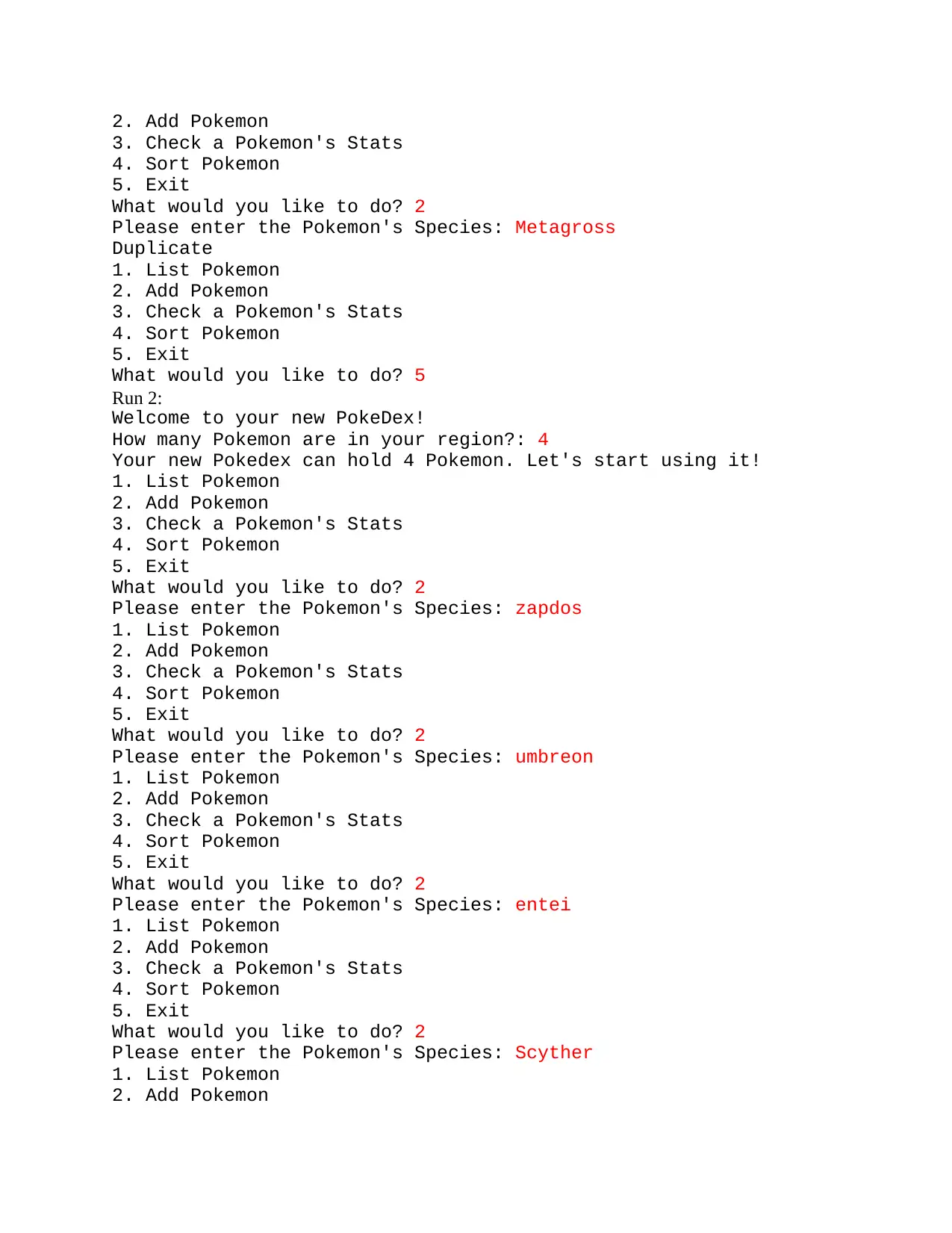
2. Add Pokemon
3. Check a Pokemon's Stats
4. Sort Pokemon
5. Exit
What would you like to do? 2
Please enter the Pokemon's Species: Metagross
Duplicate
1. List Pokemon
2. Add Pokemon
3. Check a Pokemon's Stats
4. Sort Pokemon
5. Exit
What would you like to do? 5
Run 2:
Welcome to your new PokeDex!
How many Pokemon are in your region?: 4
Your new Pokedex can hold 4 Pokemon. Let's start using it!
1. List Pokemon
2. Add Pokemon
3. Check a Pokemon's Stats
4. Sort Pokemon
5. Exit
What would you like to do? 2
Please enter the Pokemon's Species: zapdos
1. List Pokemon
2. Add Pokemon
3. Check a Pokemon's Stats
4. Sort Pokemon
5. Exit
What would you like to do? 2
Please enter the Pokemon's Species: umbreon
1. List Pokemon
2. Add Pokemon
3. Check a Pokemon's Stats
4. Sort Pokemon
5. Exit
What would you like to do? 2
Please enter the Pokemon's Species: entei
1. List Pokemon
2. Add Pokemon
3. Check a Pokemon's Stats
4. Sort Pokemon
5. Exit
What would you like to do? 2
Please enter the Pokemon's Species: Scyther
1. List Pokemon
2. Add Pokemon
3. Check a Pokemon's Stats
4. Sort Pokemon
5. Exit
What would you like to do? 2
Please enter the Pokemon's Species: Metagross
Duplicate
1. List Pokemon
2. Add Pokemon
3. Check a Pokemon's Stats
4. Sort Pokemon
5. Exit
What would you like to do? 5
Run 2:
Welcome to your new PokeDex!
How many Pokemon are in your region?: 4
Your new Pokedex can hold 4 Pokemon. Let's start using it!
1. List Pokemon
2. Add Pokemon
3. Check a Pokemon's Stats
4. Sort Pokemon
5. Exit
What would you like to do? 2
Please enter the Pokemon's Species: zapdos
1. List Pokemon
2. Add Pokemon
3. Check a Pokemon's Stats
4. Sort Pokemon
5. Exit
What would you like to do? 2
Please enter the Pokemon's Species: umbreon
1. List Pokemon
2. Add Pokemon
3. Check a Pokemon's Stats
4. Sort Pokemon
5. Exit
What would you like to do? 2
Please enter the Pokemon's Species: entei
1. List Pokemon
2. Add Pokemon
3. Check a Pokemon's Stats
4. Sort Pokemon
5. Exit
What would you like to do? 2
Please enter the Pokemon's Species: Scyther
1. List Pokemon
2. Add Pokemon
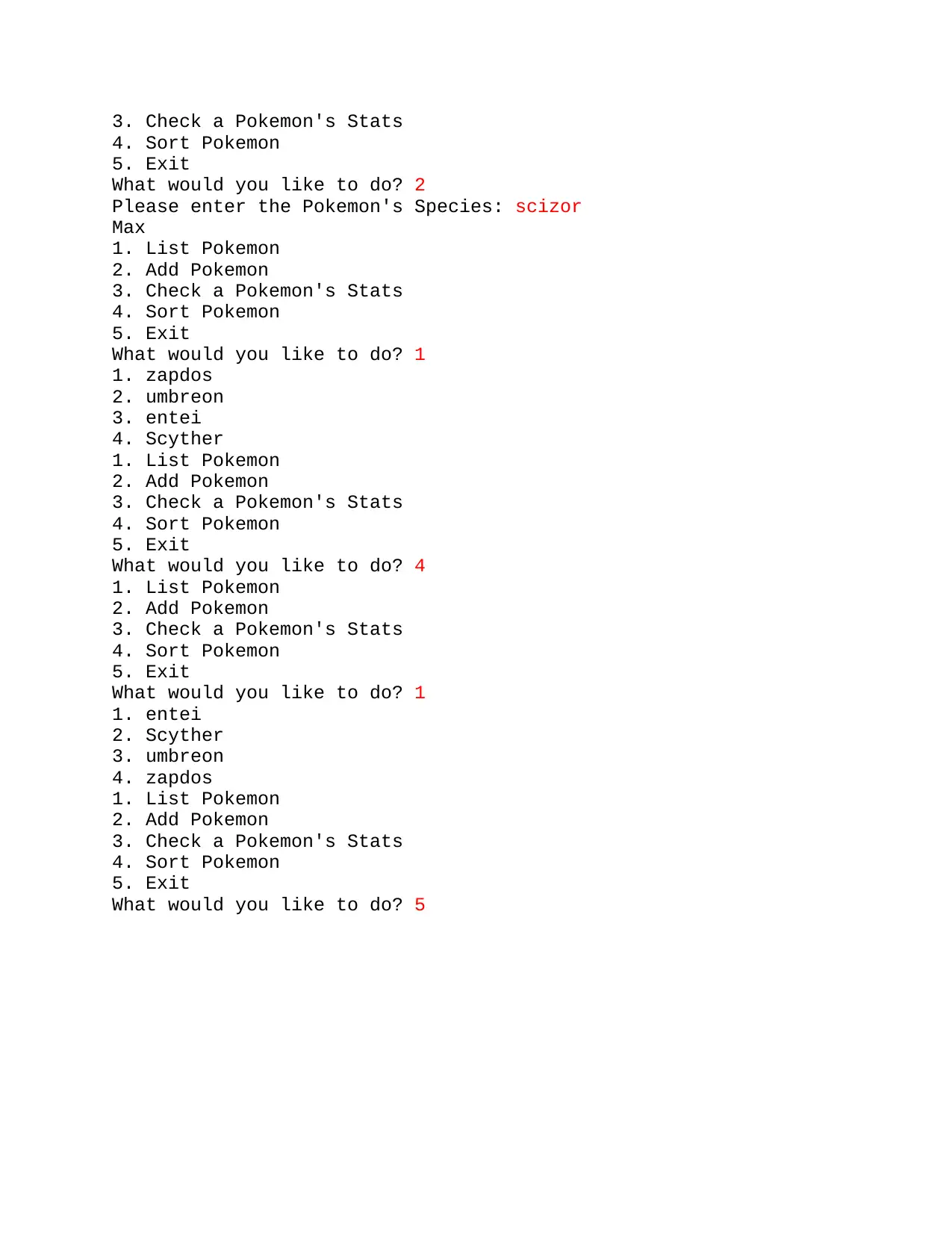
3. Check a Pokemon's Stats
4. Sort Pokemon
5. Exit
What would you like to do? 2
Please enter the Pokemon's Species: scizor
Max
1. List Pokemon
2. Add Pokemon
3. Check a Pokemon's Stats
4. Sort Pokemon
5. Exit
What would you like to do? 1
1. zapdos
2. umbreon
3. entei
4. Scyther
1. List Pokemon
2. Add Pokemon
3. Check a Pokemon's Stats
4. Sort Pokemon
5. Exit
What would you like to do? 4
1. List Pokemon
2. Add Pokemon
3. Check a Pokemon's Stats
4. Sort Pokemon
5. Exit
What would you like to do? 1
1. entei
2. Scyther
3. umbreon
4. zapdos
1. List Pokemon
2. Add Pokemon
3. Check a Pokemon's Stats
4. Sort Pokemon
5. Exit
What would you like to do? 5
4. Sort Pokemon
5. Exit
What would you like to do? 2
Please enter the Pokemon's Species: scizor
Max
1. List Pokemon
2. Add Pokemon
3. Check a Pokemon's Stats
4. Sort Pokemon
5. Exit
What would you like to do? 1
1. zapdos
2. umbreon
3. entei
4. Scyther
1. List Pokemon
2. Add Pokemon
3. Check a Pokemon's Stats
4. Sort Pokemon
5. Exit
What would you like to do? 4
1. List Pokemon
2. Add Pokemon
3. Check a Pokemon's Stats
4. Sort Pokemon
5. Exit
What would you like to do? 1
1. entei
2. Scyther
3. umbreon
4. zapdos
1. List Pokemon
2. Add Pokemon
3. Check a Pokemon's Stats
4. Sort Pokemon
5. Exit
What would you like to do? 5
⊘ This is a preview!⊘
Do you want full access?
Subscribe today to unlock all pages.

Trusted by 1+ million students worldwide
1 out of 9
Related Documents
Your All-in-One AI-Powered Toolkit for Academic Success.
+13062052269
info@desklib.com
Available 24*7 on WhatsApp / Email
![[object Object]](/_next/static/media/star-bottom.7253800d.svg)
Unlock your academic potential
Copyright © 2020–2025 A2Z Services. All Rights Reserved. Developed and managed by ZUCOL.





